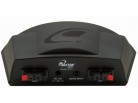Dayton Audio was kind enough to provide us with this test unit just as I had a need for it. I recently upgraded my guitar amplifier to a 33 watt tube amplifier that has several modifications to it. Previously I had used a Line 6 amp with a 1/8 plug in to hook up my IPod. I could play music through the amplifier and play the guitar along with it for practice. Now that I’ve upgraded my amplifier its time to upgrade my music setup to hook up my IPod. Enter the Dayton DTA-1 30 watt Amplifier.
The unit comes with an AC adapter that can be plugged into US or Euro outlets. The unit also shipped with a cord to plug in your external audio device. I mention my Apple products because that’s what I use but feel free to hook up just about anything that has a 1/8 plug to it.
Speaking of loud, it was time to try it with my stated purpose. I hooked up my guitar amp and hooked up some jazz and rock tunes. Seems like a near 30 watt tube amp and a 30 watt solid state amp would be perfectly matched. That’s where most people are shocked by how much louder tube equipment is to most solid state. Although they may consume similar amounts of power how they reproduce sound is very different. This means that the solid state amp is going to work a lot harder to keep up with my tube amp. With that in mind I turned the volume to about 75%. The sound this little amp produced is quite loud at this setting. Not ear splitting or headache producing but definitely at my upper limit of comfortable. Keep in mind as a musician my upper limit of comfortable is probably higher than the average person. At this setting I placed the amp between 1 and 2 on its dial and found they were comfortably matched. This is about my normal practice volume and the DTA-1 was well in its comfort zone.
I decided to see where the DTA-1 amp could go from here. As the dial approached 100% there was little volume increase but harmonic distortion increased. This is to be expected. Any device at its upper limits produces distortion – it’s to what degree and how pleasant/unpleasant this is perceived that is important. Although it is present this was one of the better solid state harmonic distortions I came across. Usually I expect a much more exaggerated distortion at these levels. The unit produced a lot of heat at this point so I only ran like this for an hour or so. 80% seems to be the practical limit to avoid harmonic distortion and at that level it’s quite loud.
Conclusions
I’m very happy with this unit. It’s small and works just as promised. This is a very good unit for listening to music in a room or even as a PC sound system. This system excels at producing good musical sound without many of the negatives associated with small solid state amplifiers. With more efficient 4 ohm speakers there should be even more volume available.
If you get this amp get a longer 1/8 cable so that you can leave your device somewhere more handy that won’t block the amp’s ventilation or cook your device. I think the best use for this amp may be with a PC system. With the 1/8 plug it will make for a clean install and the smooth bass reproduction would be great for games or listening to music.















